#captain kangaroo and his pals
Explore tagged Tumblr posts
Text




Captain Kangaroo and His Pals
100 notes
·
View notes
Text

Captain Kangaroo and His Pals (1970)
8 notes
·
View notes
Text
A lawless poacher wants to capture a majestic and rare golden eagle, so he kidnaps the boy who knows where to find the bird. Not to worry — the Rescue Aid Society’s top agents, heroic mice Miss Bianca and Bernard, fly to Australia to save the day. Accompanying the fearless duo are bumbling albatross Wilbur and local field operative Jake the Kangaroo Rat. Credits: TheMovieDb. Film Cast: Bernard (voice): Bob Newhart Miss Bianca (voice): Eva Gabor Wilbur (voice): John Candy Jake (voice): Tristan Rogers Cody (voice): Adam Ryen McLeach (voice): George C. Scott Frank (voice): Wayne Robson Krebbs (voice): Douglas Seale Joanna (voice): Frank Welker Chairman / Doctor (voice): Bernard Fox Red (voice): Peter Firth Francois (voice): Ed Gilbert Faloo / Mother (voice): Carla Meyer Nurse Mouse (voice): Russi Taylor Radio Announcer / Airplane Captain (voice): Peter Greenwood Baitmouse (voice): Billy Barty International Mice (voice) (uncredited): Mickie McGowan Film Crew: Director: Hendel Butoy Director: Mike Gabriel Screenplay: Jim Cox Screenplay: Karey Kirkpatrick Screenplay: Byron Simpson Story Supervisor: Joe Ranft Characters: Margery Sharp Producer: Thomas Schumacher Original Music Composer: Bruce Broughton Editor: Michael Kelly Animation: James Baxter Animation: Anthony DeRosa Animation: Larry White Visual Effects: Scott F. Johnston Layout: Bill Perkins Animation: Johan Klingler Special Effects: Rob Bekuhrs Title Designer: Dan Perri Associate Producer: Kathleen Gavin Casting Director: Mary V. Buck Casting Director: Susan Edelman Art Direction: Pixote Hunt Animation: Vera Pacheco Animation: Aaron Blaise Movie Reviews: CinemaSerf: Now the RAS are clearly not a very global organisation as they have to parachute in (via albatross) “Miss Bianca” and “Bernard” all the way from New York to Australia in search of the missing nine year old “Cody”. What’s happened to him? Well, he happened upon a trapped golden eagle high on a cliff top and released her. Whilst earning her undying affection, he also succeeded in earning the enmity of the bird’s hunter “McLeach”. This man, and his hapless hench-salamander “Joanna” already have a fair amount to species in their underground collection so it now falls to our determined mice and the young boy to free these critters and keep “Marahute” and her three eggs safe from this nasty poacher and his hungry pal. I quite enjoyed this. It plays a little too much to Aussie stereotype now and again, but there is plenty of fun in the adventure with some amiable characterisations – I liked “Joanna” and the rather grumpy koala – as we tear along for a quickly paced and enjoyable sequel to the 1977 story (who knew mice lived that long!?). Nope, you won’t remember it for long – but it passes eighty minutes enjoyably enough.
#alligator#australia#australian outback#baby-snatching#Diamond#eagle#kidnapping#mouse#nest#poacher#sequel#Top Rated Movies#villain#waterfall
0 notes
Note
Thoughts on The Spectre (Jim Corrigan, Hal Jordan, Crispus Allen)?
You got funny timing; I was just thinking about that guy. Because he’s one of the very, very few characters who I think just does not fit in an expanded superhero universe.

I know many are of the opinion that, say, Midnighter doesn’t belong in the same world as the likes of Plastic Man and Captain Marvel, but to me it’s never been a problem: the whole idea of a shared universe is that they can support a number of different approaches and tones while also benefiting from being able to interact on occasion. So if John Constantine is damning himself and everyone around him while Wonder Woman rides a kangaroo into space, fine by me. But the Spectre is a very specific combination: he’s too powerful to be ignored, too intimate in how he operates to be shuffled to the sidelines of a cosmic scale outside of everyone’s jurisdiction or understanding, and too fucked in concept and morality to comfortably exist side-by-side with the rest of them. He’s not just a killer, he’s not just a killer who intentionally allows people to be murdered so that he can torture their killers to death, he’s not just a dude who snatches up innocent(-ish) people and forces them to go along with it - he even made Crispus Allen kill his own son for avenging his murder - but he’s a mass-murderer who comes with God’s personal stamp of approval. Not just the authorial ‘god’, but the in-universe capital-G truth and life and way. Which means one of two things (assuming you ignore the Multiverse Map which puts God several tiers below the Overvoid - which makes sense, since the map acknowledges that this God is itself a product of the fiction that is the DCU):
1. The Spectre is interpreting his orders wrong (and always has been, not just the times he admits he did) or not receiving them from the ‘real’ God, in which case he’s not only a monster but the most dangerous supervillain in all of DC Comics, and he kind of has to be stopped, or at least no longer framed as sort of debatably a good guy.
2. He really is exactly what he says he is, in which case the absolute, inviolate moral foundation of the DCU is directly counter to everything all of its most important characters stand for. In this model, Superman, Batman, Wonder Woman, the rest of the Justice League, the Teen Titans, the Doom Patrol, the Justice Society of America, the Legion of Superheroes, the Metal Men, the Green Lantern Corps, and all the rest are completely wrong about everything, and the humanist, loving world they’ve been fighting for is in fact the opposite of what the universe wants, which is for everyone who’s done anything remotely wrong ever to die slowly in the most agonizing ways possible, before being sentenced to the judgement of the being who instituted this. Granted they’re not even supposed to administer this justice themselves, but this isn’t even a morally indifferent cosmos for Superman and his pals to bring justice to where higher powers won’t: it’s one that explicitly makes an-eye-for-an-eye the non-debatable law of the land in a universe built from day one around a completely irreconcilable vision of what justice is.
That’s the problem: not his power, not his actions, not even that he’s framed as doing the right thing (even if that often comes off as laziness or outright failure on the part of the creators), but that his actions are justified in a way that rewrites literally everything else happening in that world on the most fundamental level possible. I’m, ah, not really sure how to fix that, given it’s all built directly into the premise of his character, unless you really got into the Multiversity of it all and established that he’s either serving only one version of God among many, or the God he serves isn’t the top dog next to the likes of the Monitors and the Overvoid, in which case you still thoroughly alter at least the spirit of the premise if not the word of it. He’s an interesting enough character in enough ways that it might be worth biting that bullet to keep him around though, because near as I can see it the only alternatives are keeping the current untenable position, or pretty much scrapping him altogether.
52 notes
·
View notes
Photo

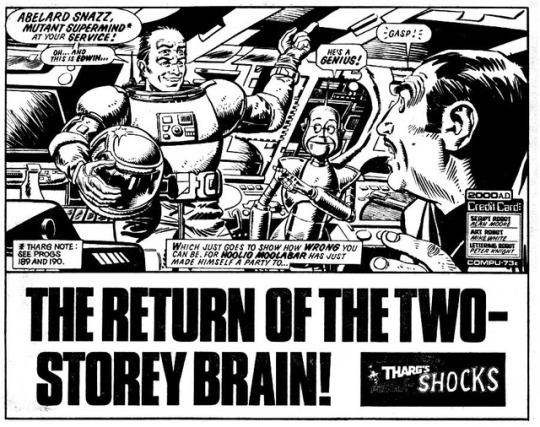

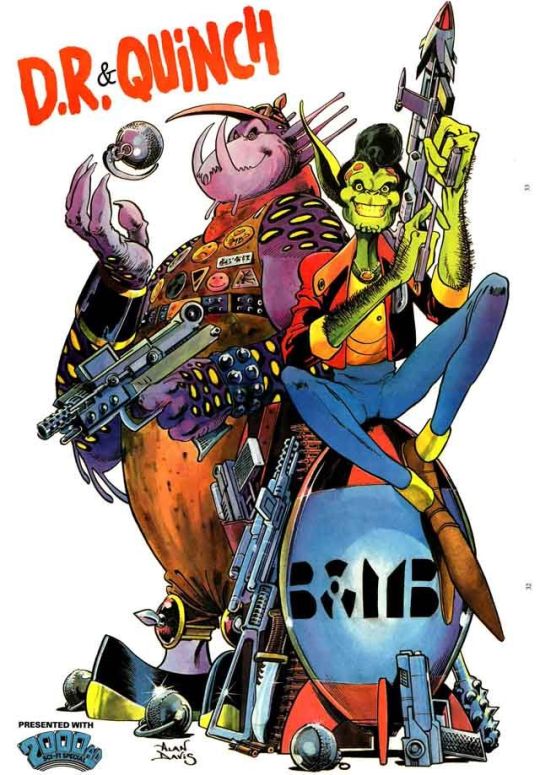
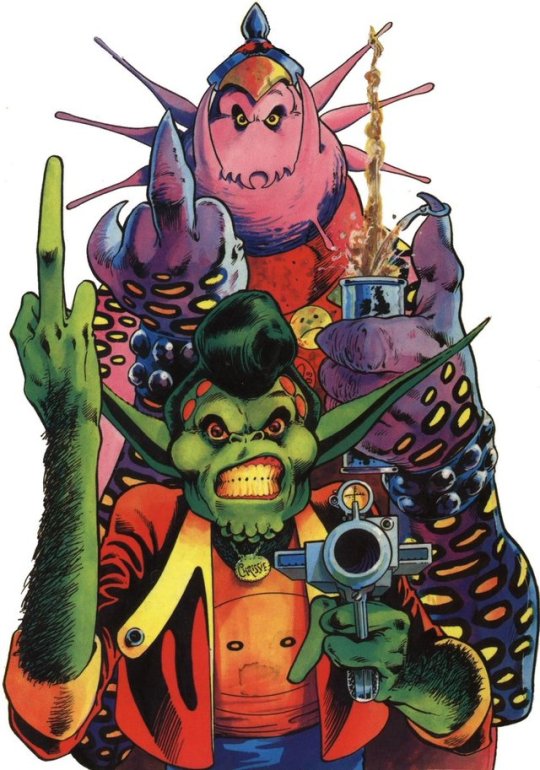
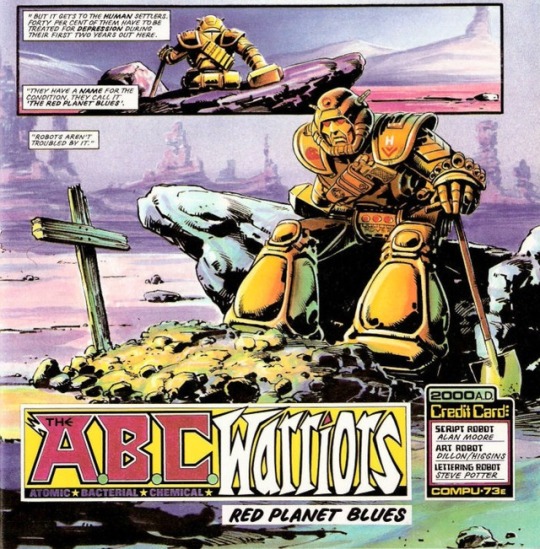

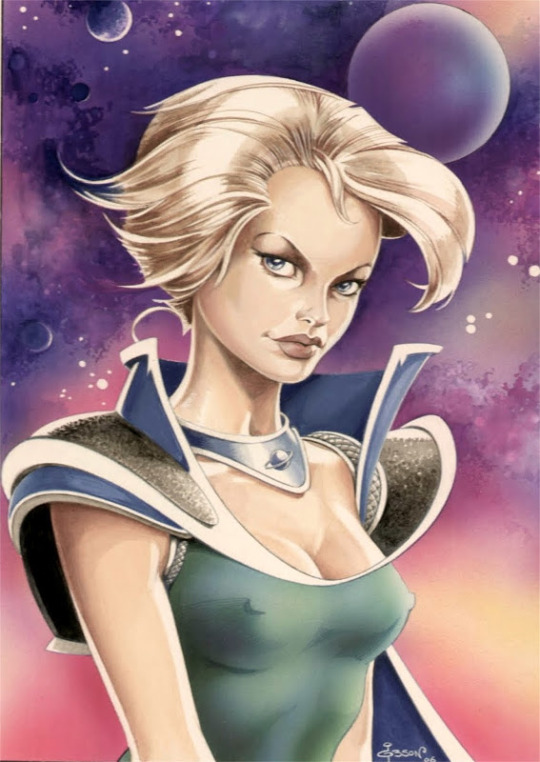


40 Years of Thrillpower: Mavericks
The Astonishing Mind of Alan Moore - Various Artists
Attention aspiring writers, any budding script droids, or comic creators of any description, if you study Alan Moore’s earliest 2000AD short stories they are perfectly penned pearly parables!
A lot can be learned from these one, two, three or more page short stories, just the right length, plenty of humour and usually with an unexpected twist or moral lesson.
Whilst at the Galaxy’s Greatest Comic™, the Moore droid sharpened the tools of his trade, writing dozens of short stories: Future Shocks, Robo-Tales and Time Twisters, before venturing into some of the comic’s best-loved series: DR & Quinch, Skizz and, of course, The Ballad of Halo Jones - the story of an ordinary girl, with extraordinary dreams - undoubtedly some of his best work, as vital and resonant now as it was when it was written, over 30 years ago.
So, whether you’re already a fan, a frustrated script droid, or just a lover of tall tales, this is the introduction to one of the finest fiction writers of his generation - and he honed his career under the guidance of The Mighty Tharg at 2000AD - where else?!
A restless, creative and prolific young droid busies himself at his desk, under the watchful gaze of the omnipotent, Tharg the Mighty! Art by Robin Smith.
An early example of the Moore droid’s mastery of the short story, The Return of the Two-Storey Brain, has an unforgettable lead character, in this case so popular that Abelard Snazz, or the 'double-decker dome' aka the ‘two-storey brain’, etc, would return for further far-fetched fabulous fails! Mike White (a).
Chronocops, with partner-in-sublime (sorry!), the legendary, Dave Gibbons, is another short story, a ‘Time Twister’, aptly, that is so simply constructed, it has been ripped off in popular culture a million times since. However, thanks to superior draughtsmanship, and gags aplenty, this is perhaps the sweetest sci-fi short of all time - a lesson in the art of the twist-in-the-tale!
Everybody’s favourite extra-terrestrial teenage delinquents, the irrepressible DR & Quinch. Starting out, unsurprisingly, as a hugely enjoyable one-off short story, a Time Twister: DR & Quinch Have Fun On Earth (Prog 317, 21Mar’83)Our anarchic heroes plan a galaxy-wide jaunt seemingly just to cause some mayhem and drokk with the backward minds of some backwater stomm-hole known as Earth. But the diabolic duo stop off throughout different eras in Earth’s distant, and more recent past, leaving their mark on this temporal journey in subtle (and not-so subtle!) ways. In fact it’s all just a..(well, visit unofficial 2000AD database, Barney, and read the whole sociopathic short story above for yourself online, for free!). Fortunately, this terrific Time Twister spawned a whole series for the terrible twosome, bringing the best out of co-creative art droid, the awesome Alan Davis (Harry Twenty on the High Rock, Captain Britain).
ABC Warriors: Red Planet Blues (2000AD Annual 1985, 1Aug’85). Although by no means a regular scribe on the Mek-nificent 7 (to be fair, as far as I know, the only other script droid other than creator Pat Mills to ever have written an ABC Warriors’ story). A soulful, introspective Hammerstein reminisces on his time on Mars with the heroic war droids - “seven robots sent to tame a planet” - lovingly scripted, with beautiful artwork from the late, great Steve Dillon & the usual perfect palette from the colouring box of John Higgins (Watchmen). Having said that, the Moore droid did pen a few short stories from ‘Ol’ Red Eye’s’ mouthy sewer droid pal, loveable scamp & former Ro-Buster, Ro-Jaws.
Skizz (Progs 308-30, 19Mar-20Aug’83) an hilarious homage to Spielberg’s E.T. (The Extra-Terrestrial), with a brilliant bit of early ‘80s blackly comic television drama, Boys From The Blackstuff thrown into the mix. A plucky working class teenage girl, Roxy, from Birmingham finds kangaroo-like alien interpreter, Zhcchz of the Tau-Ceti Imperium hiding in the garden shed. With help from loveable layabout, Loz and psychotic mental patient with-a-heart, Cornelius. The frightened, gentle creature, although highly intelligent finds himself on a noisy, polluted planet, that due to Roxy’s Midlands accent, he believes is called Burmy-gam (nice touch, for anyone familiar with a ‘Brummie’ accent) and left alone in Roxy’s family home, whilst her parents are on holiday. With Roxy at school, Skizz tries to understand Earth’s culture, and the easiest way to absorb that, is to watch TV. The mild-mannered alien whose species are largely pacifistic, is horrified by the sheer brutality and atrocities that he sees daily on the news. But, also what humans constitute as entertainment - boxing, wrestling and other contact sports, combatant or not, are complete anathema to Skizz’s race. To make matter’s worse his alien metabolism is also causing a problem, every foodstuff she tries to feed him causes a violent reaction, making him vomit. In the end Roxy discovers that baby food is a winner, and at least he won’t starve to death. Knowing that Skizz’s craft has been discovered, Roxy, with help from loveable layabout, Loz and psychotic mental patient with-a-heart, Cornelius, realise they must get the creature back to his home world, before government agencies seize him, eager to get the creature in a laboratory and see what makes him tick. Their biggest obstacle is a South African, apartheid-era scientist, van Owen, an obsessed alien-hunter, who had found Skizz’s crashed spacecraft and knows he’s in the area. Can this teenage girl, and her ragtag bunch of misfits, really hope to win against overwhelming forces, who want a living extraterrestrial to ‘study’, and will stop at nothing to get their way? A great little story, with relatable characters, that is funny, tragic and exciting in equal measures - light years ahead of Spielberg’s movie, of which it is a blatant pastiche. This wouldn’t be the last time Moore would use aliens or a plucky teenage heroine in the Galaxy’s Greatest Comic...
The Ballad of Halo Jones [Books 1-3]. (Progs 376-85, 7Jul-29Sep’84), (Progs 405-15, 16Feb-27Apr’85) & (Progs 451-66, 4Jan-19Apr’86) When Halo Jones grows bored with her life in The Hoop — a futuristic place, of where jobs are scarce and excitement is non-existent — she sets out to see the galaxy orbiting the former island of Manhattan, any way she can. But can she survive the highs and lows that lie in her path, including an extended period of shipboard servitude and a tour of duty in a terrifying war that defies the physics of space and time? This triumphant tour-de-force is the most critically acclaimed of the Moore droid’s contribution to the Galaxy’s Greatest Comic, with good reason. The only disappointing aspect of this remarkable work of fiction, sequential strip art, or not, is that it was meant initially to run to 5, 6, 7 volumes,,following an idealistic, headstrong teenager through her life, ending with a worlds-weary elderly woman,looking back on her eventful history (according to his script droid daughter, Leah Moore, that is). Either way, although unfinished it really is a super story of an optimistic innocent, taught the realistics of leaving home, and what life is really all about. In a way, though the final book leaves you wondering what happened to our heroine, we all remember her motto: “Where did she go? OUT. “What did she see?” EVERYTHING! Ultimately, though Halo Jones is a survivor, and that’s something we can all relate to... Beautifully drawn by another top creative collaborator, Ian Gibson.
71 notes
·
View notes




